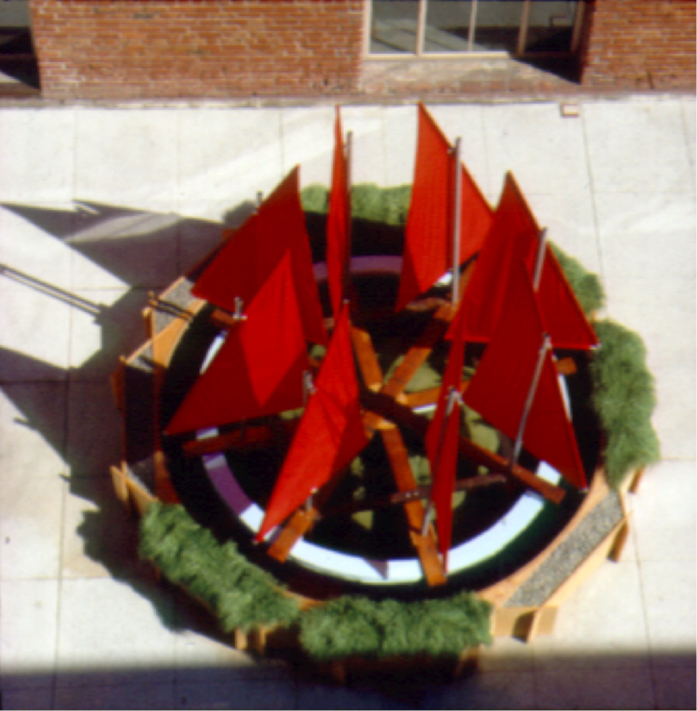December 1995/January 1996
Volume 48, Number 6
“Some people are weatherwise, but more people are otherwise”
—Benjamin Franklin
The weather may seem irrelevant to some sculptors, holed up in their studios chipping away, at an immortal stone like marble. But that’s not the type of artist who Philip Linhares, chief art curator at the Oakland Museum had in mind when he proposed a sculpture exhibit by the Pacific Rim Sculptors Group.
The group, which counts 150 northern California sculptors as its membership, installs four exhibits a year in the spacious outdoor courtyard of the Contract Design Center in San Francisco. Linhares saw this as an opportunity for a little artistic play with the weather. So last year he challenged Pacific Rim members to submit proposals for “Weather Works,” an exhibit of sculpture interacting with the atmosphere and using “weathered” media: found objects and recycled materials.
“It is a bright and windy site, perfect for a variety of ideas, from the wind-powered to the growing moving, flapping and noise making,” Linhares noted.
Unfortunately, for the first round of proposals, weather and sculptors cooperated a bit too closely. Linhares solicited their ideas in the fall of 1994, while California was enduring record rains (see “California Crazy,” page 28).
“It was raining a lot, just pouring all the time, and we all did pieces on rain, says Judith Blankman, one of the Pacific Rim sculptors. “All we could think of was rain — catching the rain, rain drops making sounds. And when we showed him (Linhares) our proposals, he said, ‘Well, I was really more interested in the wind.’ So we all went back to the drawing board.”
Linhares chose seven of the new proposals for display in the courtyard from September 14 to November 22, 1995. The exhibit was subtitled, “Nine Artists Face the Elements,” and many of the artists took full advantage of the unique winds of the courtyard, which channels air between two 80-foot long brick structures about 40 feet apart.
Mary Curtis Ratcliff tackled a familiar weather concern with her Good/Bad Hair Day, with ribbons of satin, rayon, and moiré suspended from hoops and left dangling in the air.
Russell Herman created Sun Signals, a kinetic collection of nautical elements, including steel tubes, cables, and nylon sail cloth. The flags were suspended from cables over the courtyard to send “messages to the sun and universe,” according to the artist.
Blankman’s own installation took a more introspective rack as “a metaphor for being stuck in life.” She constructed a wheel, powered by eight red sails, that could rotate in a basin of water. Each sail had one word from the work’s title, Carry Me Away From Here So I Can. Appropriately enough, the winds of the courtyard carried the work a bit too far until it could be anchored fully by its 800 pounds of ballasted bulk, and several times sails were damaged.
“I certainly felt like we were facing the elements,” Blankman admits.
Rather than completely circle the basin of water, Blankman’s wheel moves back and forth in the wind. Blankman isn’t sure what in the design of the sails encourages the piece to reverse directions, but figures the motion works with the theme. “I decided not to mess with it.”
Other pieces explore less whimsical aspects of weather. Susan Marie Johnson utilized the regenerative powers of weather with Rebirth , in which she reused dirt and dead grass from a previous installation to grow new grass and nasturtiums. In Lull , Susan Leibovitz Steinman collaborated with sound artist Eleanor Beaton to evoke the power of a hurricane. Steinman dismantled and reconfigured household objects — cribs, ironing boards, doors — while Beaton added recorded sounds from the winds of California’s shore for visitors to hear through headphones.
The outdoor exhibit turned out to be a good lesson in long-range forecasting for the Pacific Rim group. The mostly dry and sunny weather during the exhibit rendered useless many of the initial designs that had been based on last year’s rains.
“You can’t count on rain here in September,” admits Blankman. “When we have an Indian summer we may not have any wind at all. I was just thrilled when I put up the sails on my wheel because it was very blustery.”
WEATHERWISE
DECEMBER 1995/JANUARY 1996, p. 9
